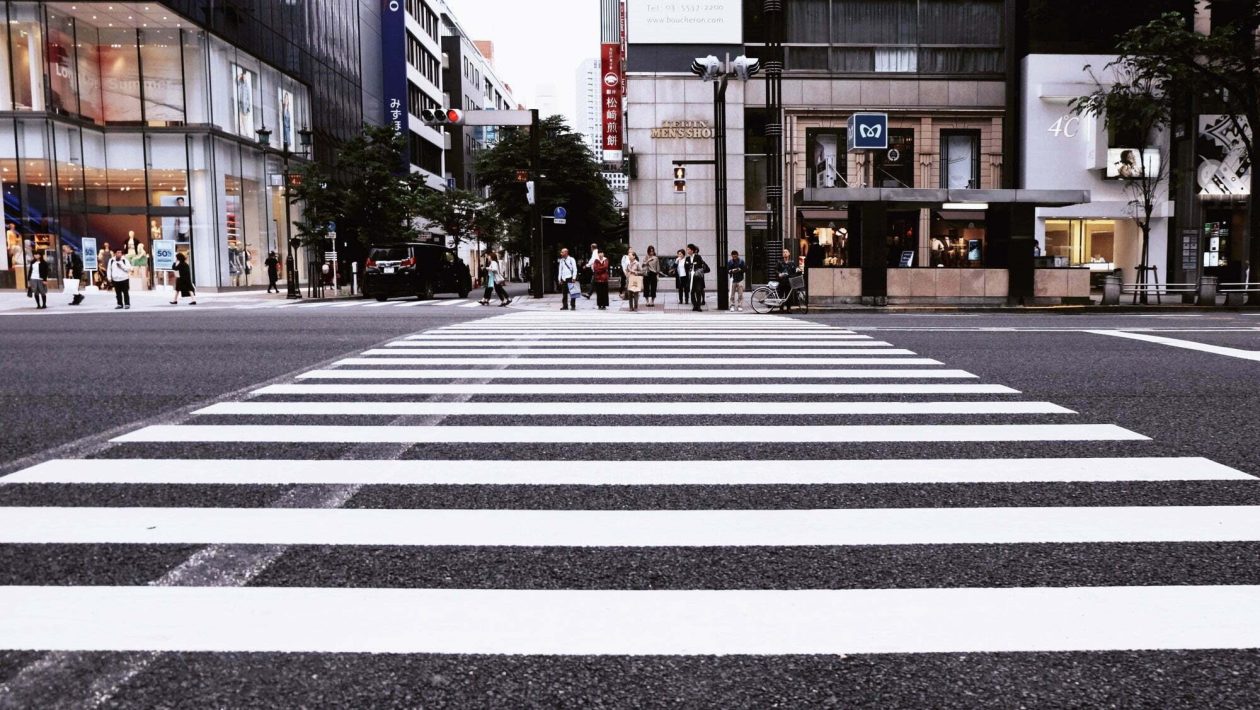In general, a pedestrian crossing is any portion of the road, sidewalk, or curb designated for persons on foot. State law requires vehicles to slow down or stop when a person is using or about to use such a crosswalk.
Pedestrians should only begin to cross when they get the “walk” signal from a traffic light.
What is a crosswalk?
A crosswalk is a place where pedestrians can safely cross the road. It can be marked or unmarked. According to the Manual on Uniform Traffic Control Devices, a crosswalk is “that portion of a roadway at an intersection included within the connections of the lateral lines of sidewalks or, in the absence of sidewalks, from the edges of the traversable roadway.”
Marked crossings typically consist of painted markings on the road surface. The most common type of marked crossing is the zebra crossing, which consists of alternately white and black stripes on the road surface. Some cities also use a flashing light or other signal to indicate that pedestrians have the right of way and that motorists should slow down or stop.
Regardless of whether or not they are marked, all pedestrians must be vigilant and always cross with caution. In addition to markings, there are other treatments that can improve pedestrian safety. Some examples include raised pedestrian crossings, curb extensions, and median islands.
Raised pedestrian crossings, also called “speed tables,” are devices that raise the road surface to encourage motorists to yield to pedestrians. In studies conducted on streets in the United States and elsewhere, raised pedestrian crossings have been found to be extremely effective in reducing vehicle speeds. They can be placed at pedestrian crossings, intersections, or in other locations where a speed table is not feasible.
Another type of pedestrian crossing is the lighted crosswalk sign. These crossings are often located in high-volume areas where pedestrians increase significantly, such as shopping malls or schools. The lighted crosses are often designed to be highly visible to nearby vehicles and may also use flashing lights or sound signals.
A lighted crosswalk is a safer alternative to unmarked crossings, which can be difficult for pedestrians to see at night or in low visibility. Unmarked crossings can also be confusing, as pedestrians must determine whether or not it is safe to cross. In addition, the uneven surface of unmarked crossings can make them dangerous for those with visual or physical impairments. Pedestrian crossings should be as smooth and uniform as possible to reduce trip hazards. The most popular materials for pedestrian crossings are thermoplastic or concrete, which are both long-lasting and easily visible.
What is a pedestrian crossing?
A pedestrian crossing is any area distinctly indicated for pedestrian crossing by lines or other markings on the road surface. The Manual on Uniform Traffic Control Devices defines a crosswalk as “part of a roadway at an intersection included within the connections of the lateral lines of sidewalks or elsewhere distinctly indicated for pedestrian crossing by devices, lines or markings on the surface.”
Marked pedestrian crossings are usually found at intersections and other locations where it is unsafe to cross unaided due to vehicle numbers, speed, or road widths. Pedestrian crossings should be located in the most direct pedestrian route and be visible to both drivers and pedestrians. In order to reduce collisions, the maximum pedestrian clearance should be provided for the longest distance possible without compromising safety and visibility.
Pedestrian crossings should be clearly defined by pavement markings such as dotted lines and stripes or a white/yellow painted outline. They should also be distinguished from the adjacent traffic lanes by a raised edge or curb extension and be separated from other crossings by barriers or a raised median. In addition, they should be marked with a pedestrian warning sign or a pedestrian pushbutton. In the case of a pushbutton, it should be equipped with a symbol showing the crossing situation for visually impaired pedestrians.
Pedestrians must obey the signals for signalized intersections and only cross during the “Walk” or person symbol. They should not continue to cross if the signal changes to the “Don’t Walk” or upraised hand symbol. Pedestrians are encouraged to walk in groups and to use a crosswalk with a raised edge or curb extension where possible.
Jaywalking, or crossing the street outside designated crosswalks, is dangerous and can lead to injury and death. Pedestrian crossings are essential for pedestrian safety, but pedestrians need to be aware of their surroundings and follow the rules of the road. In addition, it is important for motorists to be on the lookout for pedestrians and to slow down and yield when approaching them.
To encourage pedestrians to travel on foot, cities and towns must provide a safe and convenient network of pedestrian routes, including sidewalks, crosswalks, and traffic signals coordinated with vehicle signals. They should also work with local schools to promote walking and biking to school. Adding new housing options in walkable areas, encouraging public transit, and improving the quality of existing infrastructure can help people get around on foot.
What is the difference between a crosswalk and a pedestrian crossing?
The terms crossing and crosswalk are often used interchangeably, but they refer to different aspects of the same thing. Crossing means to move from one side of the road to the other on foot, while a crosswalk is a designated area where pedestrians are given the right of way over vehicles. Crosswalks are typically marked with painted lines and may also include signals or other features to increase safety.
Pedestrians must always use caution when crossing streets, even if the intersection is not marked with a crosswalk. However, a crosswalk is a safer option because it indicates that drivers must yield to pedestrians. In addition, most intersections with crosswalks have signals that tell pedestrians when it is safe to begin crossing the street. If pedestrians are not using the signal or going against its instructions, they may be violating the law.
While crosswalks are often found at intersections, they can also be placed in mid-block locations to minimize the distance between corner crosswalks. These locations are usually identified by signs or other special markings or lines on the roadway. In these instances, pedestrians must still obey all traffic laws but are not required to cross within the marked crossing areas.
Another difference between a pedestrian crossing and a crosswalk is that specific signs, pavement markings, overhead signs, and push buttons often identify the latter. The latter is most common in schools and outdoor shopping districts and can be differentiated from a regular crossing location by the presence of these devices.
While some drivers believe that pedestrians only have the right of way when they are in a marked crosswalk, this is not true. The law states that a pedestrian has the right of way wherever they are in the roadway, as long as they have taken all necessary precautions before beginning to cross. This includes crossing outside of a marked crosswalk and even in the middle of the block between parked cars.
In order to minimize the number of pedestrians who are injured on the roads, it is important for everyone to understand the difference between a crossing and a crosswalk. By understanding these distinctions, pedestrians can make informed decisions about where it is safe to cross the street and when they should use a marked crossing location. In addition, drivers should be aware that crossing and crosswalks are not the only way to get pedestrians safely across busy roads, and should consider a range of treatments, such as raised crossing islands, sidewalk extensions, traffic signals, roadway narrowing, and enhanced overhead lighting.
What is the difference between a pedestrian crossover and a pedestrian crossing?
A pedestrian crossover and a pedestrian crossing are both specific locations where a pedestrian has the right of way over vehicles on the roadway. These areas are typically denoted by pavement markings and a change in the texture of the concrete or asphalt. In some cases, this difference is accentuated by signs or overhead lights. It is important for pedestrians to always be aware of their surroundings and to cross the street with extreme caution, regardless of whether they are in a marked or unmarked crossing.
Pedestrian crossovers are usually found at intersections with high vehicle and pedestrian traffic volumes, such as along school routes and in signalized and four-way stop intersections. They may also be found at midblock locations to minimize the distance between corner crosswalks. Signs and overhead lights, such as a zebra crossing, puffin crossing, toucan crossing, or pegasus crossing sometimes mark them. The rules of pedestrian crossovers are very similar to those of crosswalks, except that a driver must yield to pedestrians who are in the lane of travel and who are crossing into the roadway.
The main difference between a pedestrian crossover and a crosswalk is that signs, pavement markings, and pedestrian push buttons specifically indicate a pedestrian crossover. A zebra or puffin crossing, on the other hand, is denoted by a flashing light and a red-and-white stop sign. Generally, a pedestrian must yield to drivers outside a marked crosswalk.
Although most drivers are expected to yield to pedestrians within a crosswalk, some do not obey this law. This can be due to a lack of visibility or because they believe that pedestrians are a danger to them. Regardless of the reason, pedestrians should always make eye contact with drivers before crossing to ensure that the driver sees them and can safely continue their journey across the road.
Pedestrians should never assume that a driver will yield to them, regardless of whether they are in a crosswalk or not. Drivers should always be on the lookout for pedestrians and be prepared to slow down or stop if needed.





